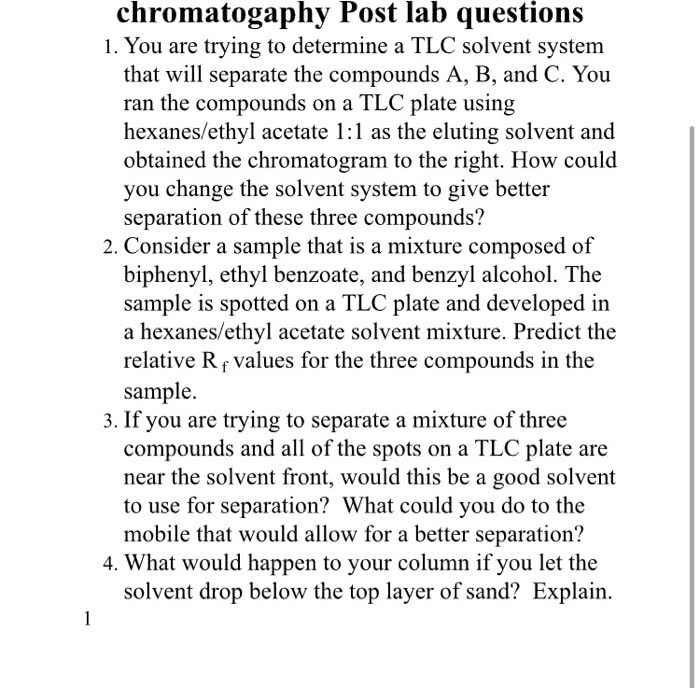What would be the result of failing to mark the solvent front after developing a TLC plate? Would this affect
your ability to calculate component R
f
values? Why or why not?
2. What would happen if your origin line was oriented so low on the TLC plate that when it was lowered into the
TLC chamber it was positioned below the level of the developing solvent (eluent)?
3. Assuming that the separation of a binary mixture in ideal
circumstances (concentrated spotting) would be
relatively small (less than 0.5 cm), what would be the result of applying too large a spot of this mixture to the
TLC plate? How would it affect your ability to distinguish one component from the other on the
plate? How
would it affect your R
f
values? Draw a sample TLC plate to help illustrate your answer.
4. Unknown compound Q is spotted on a TLC plate that is then developed in cyclohexane. The solvent front is
measured at 5.2 cm and the distance traveled b
y compound Q is measured at 3.4 cm. A sample of
acetaminophen is spotted on a TLC plate that is then developed in cyclohexane. The solvent front is
measured at 4.15 cm and the distance traveled by
acetaminophen
is measured at 2.70 cm. What can be
determined abo
ut the identity of compound Q in light of this data?
5. Describe how TLC could be used to monitor a reactionâs progress (product & byproduct formation) in a
research/teaching laboratory.
What would be the result of failing to mark the solvent front after developing a TLC plate? Would this affect
your ability to calculate component R
f
values? Why or why not?
2. What would happen if your origin line was oriented so low on the TLC plate that when it was lowered into the
TLC chamber it was positioned below the level of the developing solvent (eluent)?
3. Assuming that the separation of a binary mixture in ideal
circumstances (concentrated spotting) would be
relatively small (less than 0.5 cm), what would be the result of applying too large a spot of this mixture to the
TLC plate? How would it affect your ability to distinguish one component from the other on the
plate? How
would it affect your R
f
values? Draw a sample TLC plate to help illustrate your answer.
4. Unknown compound Q is spotted on a TLC plate that is then developed in cyclohexane. The solvent front is
measured at 5.2 cm and the distance traveled b
y compound Q is measured at 3.4 cm. A sample of
acetaminophen is spotted on a TLC plate that is then developed in cyclohexane. The solvent front is
measured at 4.15 cm and the distance traveled by
acetaminophen
is measured at 2.70 cm. What can be
determined abo
ut the identity of compound Q in light of this data?
5. Describe how TLC could be used to monitor a reactionâs progress (product & byproduct formation) in a
research/teaching laboratory.


